X
CONTACT US
Great Lakes Center, SAMC 319
SUNY Buffalo State
1300 Elmwood Ave., Buffalo, NY 14222
wnyprism@buffalostate.edu
(716) 878.4708
SUBSCRIBE TO LISTSERV
FOLLOW US
CONTACT

Black jetbead flower and fruit. Photo Credit:Leslie J. Mehrhoff, University of Connecticut, Bugwood.org
Black Jetbead
COMMON NAME:
Black JetbeadSCIENTIFIC NAME:
Rhodotypos scandensORIGIN:
AsiaDESCRIPTION:
Black jetbead is a deciduous shrub that can grow up to 5 feet tall. It has bright green leaves that are opposite and doubly serrate with a rough leaf surface. It produces small, white flowers with four-petals that grow in terminal clusters. These flowers develop into shiny, black fruit that mature in the fall and can persist over winter.HABITAT:
Black jetbead is most commonly found in disturbed areas with degraded soils. It grows in either full sun or full shade but prefers moist, well-drained soils. It is commonly found along roadsides, forest edges and forest understories.THREAT:
This plant can form a dense shrub layer that shades out native species and restricts the establishment of tree seedlings.MANAGEMENT:
Smaller shrubs and infestations can be pulled by hand. Larger shrubs and infestations can be treated with herbicide using cut-stump, foliar or basal bark applications.
WNY PRISM PRIORITY:
Data Gap Priority Species
Tier 2 - Eradication
ADDITIONAL RESOURCES:
Pennsylvania Department of Natural Resources
USDA Forest Service, Forest Health
Native Alternatives
Winterberry (Ilex verticillata)
Spicebush (Lindera benzoin)
Black Chokeberry (Aronia melancarpa)
NYS Prohibited and Regulated Species - Part 575:
PATHWAYS OF INVASION:
Black jetbead was introduced to North America as an ornamental plant. It spreads primarily through root suckers and seeds that are moved by wildlife.
REGIONAL DISTRIBUTION:
Known locations in Erie, Niagara and Wyoming counties.
MAP (via iMapInvasives):
To view more information for each point, zoom in, click on the point and select the "Maximize" symbol. Click "More info" to open the iMapInvasives record.
This map shows confirmed observations (green points) submitted to the NYS Invasive Species Database.
Absence of data does not necessarily mean absence of the species at that site, but that it has not been reported there.
For more information, please visit iMapInvasives.





